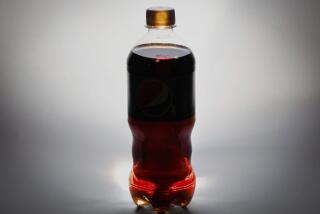Risk Is ‘Very Low’ but Experts Disagree on Possible Dangers : Study of Toxins Includes Peanut Butter Mold
That great American staple in the diet of most adolescents--the peanut butter sandwich--has joined the list of foods that some believe could cause cancer, yet experts in toxicology are split over just how genuine the threat is.
Aflatoxin, a chemical produced by the fungus Aspergillus flavus, Friday was added to the list of chemicals that the state of California believes to be carcinogenic.
Does that mean parents should tell their children to toss out their peanut butter sandwiches?
Risk Is Very Low
“They should definitely not throw out their peanut butter,” said Martyn T. Smith, an associate professor of public health at UC Berkeley and a specialist on toxins. “The risk is very, very low from the average sandwich. Of course, if you live off of peanut butter, that’s another thing.”
He added that his daughter eats peanut butter, and he sees no reason to make her stop.
Like so many suspected carcinogens, the danger from aflatoxins is a matter of considerable debate among experts. And while many would argue that it poses a health hazard at various stages of its exposure to the environment, most end products--such as peanut butter--are tested and discarded if the concentration is above allowable limits.
Under federal regulations, aflatoxins can add up to no more than 20 parts per billion in peanut butter, a level established in 1969 because at that time that was the smallest quantity that could be detected.
Forms in Mold
Keith Pfeifer, a staff toxicologist with the California Department of Food and Agriculture, said aflatoxins form in a mold that grows on such crops as corn and peanuts after the crops have been harvested and are in storage. Peanuts usually are grown in damp regions, thus facilitating the growth of the fungus.
“There are different forms of aflatoxins,” Pfeifer said. “The one that receives the most notoriety is aflatoxin B-1, and that is highly toxic to the liver of most animal species. In some studies in Africa and Asia, there is evidence that it is a human liver carcinogen.”
Aflatoxins have figured prominently in the studies of Bruce Ames of the University of California, Berkeley, who has argued that many such naturally occurring chemicals are far more dangerous than many man-made substances, such as pesticides, that generally get far more attention.
In the April 17 issue of Science magazine, Ames described aflatoxins as “among the most potent rodent carcinogens,” and he suggested that the substance could have the same effect on humans, especially in Third World countries.
Study of Potency
“Considering the potency of those mold toxins that have been tested and the widespread contamination of food with molds, they may represent the most significant carcinogenic pollution of the food supply in developing countries,” Ames reported in the Science article. “Such pollution is much less severe in industrialized countries, due to refrigeration and modern techniques of agriculture and storage, including use of synthetic pesticides and fumigants.”
Ames’ contention that aflatoxins cause cancer in humans was challenged in the same magazine last month by Leonard Stoloff, a Maryland toxicologist. Stoloff contended that the role of aflatoxins is unclear because in cases where it was suspected of causing cancer in humans, the victims were also suffering from the hepatitis B virus.
Experts are in agreement that substantial concentrations of aflatoxins have proven fatal to laboratory animals, and a 1982 meeting of the International Agency for Research on Cancer concluded that it is “credible” that the same could be true for humans. But it also suggested that the facts are not yet fully known.
One problem confronting toxicologists is that it is very difficult to isolate aflatoxins in nature.
Can’t Tell It’s There
“It’s just about impossible to keep it from getting into the peanuts, and there’s no way to tell if it’s there,” because it forms on the inside of the shell, UC Berkeley’s Smith said.
Besides, he noted, with millions of peanuts, “there’s no way you could sort them out.”
It’s just like one bad apple in a very large barrel of fruit, he noted.
However, after the peanuts are processed, it is possible to test the material for aflatoxins, and peanut butter averages about two parts per billion, he said. That is well below the 20 parts per billion allowed under U.S. Food and Drug Administration regulations.
So Smith concludes that there is no reason to throw out the peanut butter. But moderation is still the recommended course.
“You should limit your exposure,” he said.
More to Read
Sign up for Essential California
The most important California stories and recommendations in your inbox every morning.
You may occasionally receive promotional content from the Los Angeles Times.







